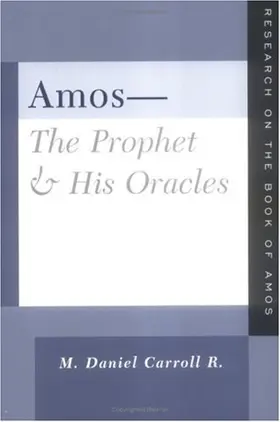

Amos-The Prophet and His Oracles: Research on the Book of Amos
Pages
320 pages
Publisher
Westminster John Knox
Published
8/1/2002
ISBN-13
9780664224554
Collections
This book appears in the following featured collections.
- Recommended OT Commentaries by Denver Seminary Journal
Reviews
A survey of research done over the last century, including minority and Two-Thirds World perspectives. Includes bibliographies of this research and for topics and passages.
[Full Review]
In this volume Carroll R. presents an up-to-date introduction to research on the book named for the prophet Amos. Two immediate questions surface with this observation. First, what is the necessity of a book like this? Second, how long can it remain up to date? The answers to these questions are related. Books like this one are of increasing value now that research and publishing in a field such as biblical studies is expanding at a rate so fast that no one can keep up with it. Those wishing to begin any kind of research project involving the book of Amos have a great place to start and can thank Carroll R. for saving them a great deal of time. Because new research is appearing constantly, the usefulness of such a book begins to diminish almost immediately, though slowly at first. A work such as this one begs for electronic publication that can be updated frequently without the lag time and high cost of reprinting. Part 1 of this book contains three well-developed essays on Amos research. The first essay is an admirable attempt to summarize Amos research from the beginning of the critical era until 1990. Wellhausen is taken as a starting point, and Carroll R. traces the development of research on Amos from romantic notions of Amos �as a religious innovator� (4) through attempts to define and understand the prophetic experience to efforts at isolating the words of the historical Amos from the whole of the book called Amos. Carroll R.
[Full Review]
With no claim to being exhaustive, this comprehensive examination of the state of Amos research over the past century and more is one of the most useful available, a status it holds for more reasons than just its being the most current. It excels because of the three substantial but concisely written essays that make up part 1 of the two-part book. These essays provide a strong sense of the intellectual and historical context of the wealth of material listed in the bibliographies of part 2, while their copious footnotes provide added details about the intricacies of many of the reviewed debates and issues. In the first of the essays, �A History of Amos Research: From Wellhausen until 1990� (3�30) Carroll R. illustrates how late nine teenth- and twentieth-century commentators investigated Amos�s contributi on to the rise of ethical monotheism or his experiences as an ecstatic or tried to recover the ipsissima verba of the prophet. He illustrates well the shifting fortunes of some ideas. An enthusiasm for calling Amos a �cult-prophet� eventually arose, challenging previous work. This enthusiasm was moderated in subsequent research. A review of form and tradition criticism brings the history into the 1980s and 1990s. The author concludes that the diverse comparative and textual approaches led to theories of various plausibility and to a number of scholars eventually abandoning these methods in favor of alternative interests. A second part of this essay details the �Quest for what lies behind, withi n, and in front of the text.
[Full Review]
Reading M. Daniel Carroll R.’s Amos—The Prophet and His Oracles: Research on theBook of Amos is like being taken on a private tour in a library. The author is intimatelyfamiliar with the content of the books and has organized them to aid research. Carroll R.sets out as his hope that “this introduction to Amos research might serve to promotefurther study of this prophetic text” (vii).The book consists of two sections, one of essays and another of bibliographies. In theessays the author explores the history of research on Amos. It covers the period fromWellhausen until 1990. Wellhausen (in 1878) suggested that there was a rift between theprophets and sacrificial religion. As a result, scholars, in varying degrees and emphases,wrote about the separation between Amos’s theology and the practice of the cult. Amoswas seen as a “religious innovator” (4) and portrayed by some as “champion of themarginalized” (7). During the same period, the idea of ecstasy was also explored. Fromanother angle, some wanted to single out the original words of the prophets by isolatingthe prophetic utterance from the (later) written context, while others from a literary-critical point of view looked for the most authentic (i.e., earliest) message. This periodsought in different ways to find the center of the “prophetic genius” (12).
[Full Review]

